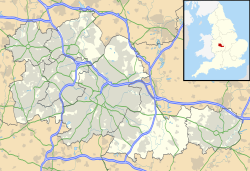| Metchley Fort | |
|---|---|
 The site of the praetentura, pictured here in 2009 | |
| Founded during the reign of | Claudius |
| Founded | c. AD 48 |
| Abandoned | c. AD 200 |
| Place in the Roman world | |
| Province | Britannia |
| Directly connected to | Icknield Street |
| Structure | |
| — Second fort structure — | |
| Built during the reign of | Domitian |
| Built | AD 90 |
| — Timber structure — | |
| Built during the reign of | Claudius |
| Built | c. AD 48 |
| Stationed military units | |
| — Legions — | |
| Legio XIV Gemina and Legio XX Valeria Victrix | |
| Events | Boudican revolt (possibly) |
| Location | |
| Coordinates | 52°27′01″N1°56′17″W / 52.4504°N 1.938°W |
| Place name | Metchley |
| Town | Birmingham |
| County | West Midlands |
| Country | England |
| Reference | |
| UK-OSNG reference | SN643564 |
| Site notes | |
| Discovery year | c. 1781 |
| Condition | Earthworks, crop marks and ditches; buried ruins |
| Controlled by | Scheduled Monument (SAM: CD129) |
| Excavation dates | 1934–present |
| Archaeologists | Mick Aston |
Metchley Fort was a Roman fort in what is now Birmingham, England. [1] It was built across four phases using a north-to-south plan. [2]












